Several weeks ago, I highlighted a beautiful vintage whitework tablecloth, embellished with coronation cord. Since then, I’ve done a little exploring. Besides finding out that Lacis regular offers some coronation cord on their website (I purchased some of theirs to see what it looks like), I found that there’s one book in print still that focuses on coronation cord (called Coronation Cord Remembered, also available through Lacis), and several booklets out of print that highlight the use of coronation cord especially in crochet and tatting, with some mentions of its uses in embroidery.
I haven’t explored the whole coronation cord question as much as I’d like to – some day, I will! In the meantime, though, I thought I should show you the stuff available from Lacis. I have to admit, it isn’t quite what I expected. If it’s something you’d like to play around with on whitework, you might want to see it, too, so that you can decide if it’s what you’re looking for.
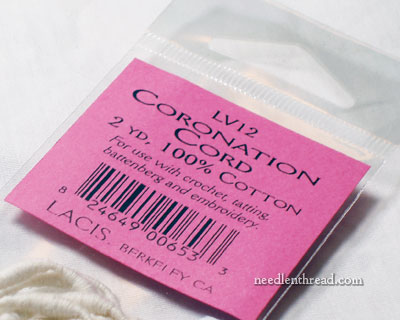
You can purchase coronation cord from Lacis by the foot (at 90¢ per foot) or in 2-yard put-ups for $5.00 for 2 yards. The description doesn’t specify the color. I assumed white, but you know what they say about assuming, don’t you?!
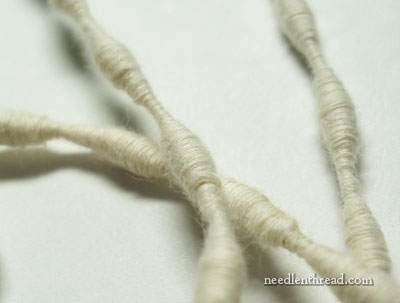
In fact, it is ecru – definitely a “raw” unbleached color. The string that wraps the outer layer of the cord is somewhat fuzzy, and it is not mercerized, so there is no sheen to it. It is also quite irregular – not smooth at all.
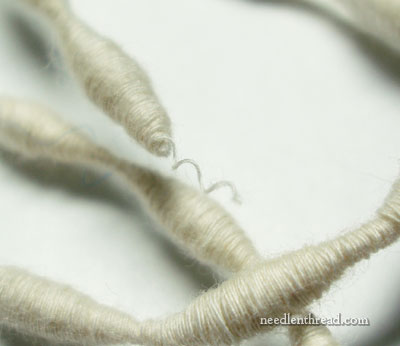
Coronation cord is made in what looks like a kind of double-wrap method. Each bump is made of strings, wrapped to shape the bump, and then the whole cord is wrapped again on the outside, to form the final layer of wraps. When you pull on one string on the end, both strings unravel.
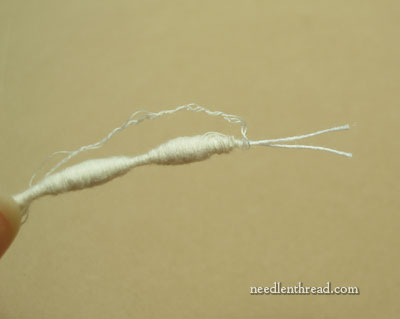
Surprisingly enough, the core is made of two little strings that are white-white (!) and mercerized (?). I couldn’t quite figure out why the inside core strings are truly white and mercerized, while the outside is raw, somewhat fuzzy, unbleached string.
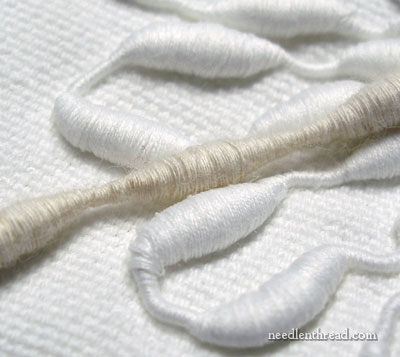
Where you really see the difference in the quality of the cord is when it is placed next to the white coronation cord on the vintage tablecloth.
There’s a huge difference here! The most noticeable is the color. Then, there’s the size (from the books I’ve read, that’s understandable, as coronation cord was available in several different sizes and a whole range of colors). The cord I purchased from Lacis is not as plump. But to me, the most disappointing difference is in the quality of the thread. The white on the vintage tablecloth is a mercerized, smooth thread, and the wrapping of the thread is all very regular and neat. The Lacis cord doesn’t hold a candle to the vintage stuff!
I would be hard pressed to use the cord I purchased in any whitework project where I wanted a “pretty” result. However, I can see its uses for other things. And in fact, I’ll be showing you one of those uses, in my Stitch Play series. I haven’t finished playing with it yet, so my idea might, in fact, be a disaster. But if it works, it could be an interesting way to make use of this coronation cord.
If coronation cord caught your fancy when we talked about it several weeks ago, and you’re on the lookout for the stuff, just be aware that the cord currently available from Lacis is not quite the same quality as the cord that you’ll often see embellishing vintage linens.
Incidentally, I received an e-mail from a reader, shortly after the previous article on coronation cord. She came across a beautiful doily at an estate sale right after that article came out, and it was embellished with coronation cord, which she recognized after reading the last article. The lady told her it was trapunto, but she knew better, bought the piece (for only $3.00!) and now has a gorgeous example of coronation cord used in whitework embroidery. The moral of the story: keep your eye out for coronation cord embroidery – you never know where it will turn up, and you may end up picking up something lovely – for a bargain!
Things like that, for some reason, never happen to me – but I hope they happen to you!
Enjoy your weekend!







Mary, I’ve got some coronation cord in some antique pieces. I think PieceWork did an article years ago about it–and how to make your own–not sure if I kept the copy…anyway, maybe someone might have it? If there’s any interest, I can look for it among my tatting books/articles :0)
Hi, Marti – Yes, I think they did two articles on it – in July / August 96 and in March / April, 2000. I just realized (by looking up the topic in their topics index) that their second article was also called “Coronation Cord Revisited” – not intentional! I haven’t seen either of the articles yet, but I’m going to see if I can track them down. Thanks! ~MC
So disappointing. I think I would use this to experiment with colouring, using paint or dye.
Okay, I don’t mean to be mean, but I find this stuff creepy! Not sure why, I think it’s because they look like cocoons and I find all bugs/larva creepy. *shivers*
That’s ok, so do I, Heather, and the stuff produced by Lacis is even more so, because with the fuzziness and the ecru / raw look, they really look like cocoons… But I think it will be useful for what I’m thinking of – we shall see!
Maybe that’s why I am interested in it. I love playing around with silk fibres both ‘prettied up’ and straight out of the cocoon as well as the cocoons and rods.
Hi Maymentor and Happy MARCH ! ! Think SPRING ! ! So glad you “revisited” coronation cord cause I missed the first installment and this is definitely something I would work with. (Anything if it’s “easy” or for me “Idiot’s Delight”….ha ha Thanks…Judy<3 in PIttsburgh
The Antique Pattern Library might have books/articles on Coronation Cord….most interesting about the differences in modern vs vintage cord.
Can’t remember how I arrived here, but I’m DELIGHTED to have found your site! I really enjoy embroidery and never have enough patterns. Also I love learning more about history and stitches etc but there really is a limit to the number of books I can afford to buy on the subject! I’ve been hopping around your site reading this and that, and I copied a couple of your monogramme patterns, they are so very elegant. Thank you for this and I’ve signed up for your newsletter, so I’ll be enjoying more of your company!!
Thanks, heckety – I’m glad you enjoy the site and have found a lot of useful Stuff!! 🙂 ~MC
I can understand your disappointment with this cord, Mary. But for my purposes it could be perfect: I tend to make, um.. contemporary embroideries, so the very imperfections of this cord would suit me well. Thank you for pointing me the right direction. I can only hope they will post it to Australia without charging the national debt. And I wish you well in finding some white and perfect coronation cord.
By the way, why is it called that?
Well, thanks to Bobbi Chase, here’s the answer on the name (she answered the question in the previous post I had on coronation cord, in the comment area): When they first tried to market this cord, they actually had a couple different names for it (rice cord, for example – you still see it called that in descriptions of vintage linens – and torpedo cord), but with those names, it didn’t sell. So they changed the name again to “coronation cord” and it took off! The name was apparently just a marketing strategy…. MC
Mary, I’m glad you found that Piecework published articles–looked for them, haven’t found them yet–wasn’t sure if it was Piecework or another magazine :0)
Aloha Mary,
If you have any “Restoration” a cleaning product, you might try soaking the coronation cord in that to get it white.
Regards,
ji
Dear Mary:
Well, you’ve finally done it. You’ve come up with a needlework style/technique/material that not only do I have no interest in doing myself, but also I don’t even want in my house. It reminds me far too much of my early attempts at spinning wool!
Hi, Sandy! That made me chuckle! I do like the coronation cord on the vintage linens I’ve found, but you’re right, I’m not too impressed with this particular cord….! ~MC
Thanks Mary for testing the Lacis cord on your dime! It’s not at all like the vintage cord that is finely spun & has a slight sheen. In addition to other uses you’ve mentioned, vintage cord makes great roses & buds when worked with silk ribbon embroidery. The little bumps can be nested together & look sort of like bullion roses. I do agree with another comment–the Lacis cord could work for a more contemporary application, adding texture & visual interest where the fuzziness & irregularity would be part of the intended design. At least you’ve let us know what to expect if we place an order with Lacis!
Mary you are getting a bit scarey…I was looking at this book last week and put it on order. The first book was a no go with me for basically for the same reason.
I am looking forward to reading it. It is not so dear either.
Second for writing is the coronation rice braid. I love it and had a little bit left that was my Mother’s. It is as white as white and really finely bound and soft. Has not been on my mind for years knowing it is hard to get so I decided to surf.
Well I found the Lacis and it does look loose and the colour would not be for white work but ecru crochet.
So I surfed on, well bless the computer I turned up some metal bound braid and bought 4 yards alas like you I never hit the sales with any luck and I paid $11 per yard but I had to have it as I thought of a design for gold work.
I did find other cottons and bought what was on sale 3 yards of white. So I am looking forward to seeing both lots
I’ll let you know what they are like and if I bought a pup.
I met a lady at embroidery guild and she too whatches your site. Not quite a cheering squad but who knows it might grow. She is doing the Nesting Place and is doing quite well. Have to say she loves it.
Cheers for now to you and all.
MM
I have an original Application of Coronation Cord 1915 booklet. Plus some vintage crochet and tatting on the cord I purchased at an estate sale.
Thank you so much for the information about coronation cord. I had never heard of it until a member of Just Tatting, Anitra Stone, pointed out it was what my grandmother had used in the tatted baby bonnet I have. Then another member, Evelyn Kremer, sent me the link to you. The cord used is off white but I assumed it was due to the bonnet’s age. My grandmother died in 1938.
I have been interested in the cord for a while so was happy to run across this post. I suspect there are actually good reasons for the construction of the cord. the better quality thread that is at the base is what keeps the cord together so it is the strength of the cording. if it were to fail the padding could go all over. the cheaper thread would be the “padding cord” and thus did not need to be of better quality and did not really need to match the inner core threads or the threads that match the lace one is making. This is often done with crochet padding cord or needle lace cording. It would allow lace makers and needle workers to wrap or crochet over the cord with the more expensive better quality thread that they were creating their work with. If the cord is wrapped tightly it and then tacked in place, it would hold its shape more than if it was satin stitched down. Just my thoughts on the idea.